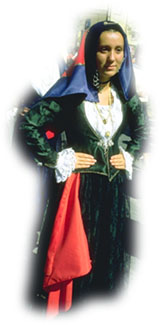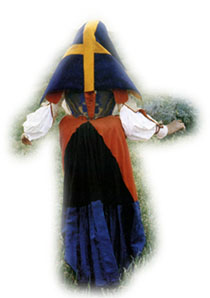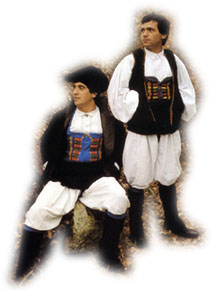 |
|
For instance it
is wrong to believe that widows always dressed in black. In fact, in some villages widows
wore a green and gold brocade top. Once it was easy to notice the difference between rich and
poor women, because rich women wore dark red clothes while poor women had to be satisfied
with undyed clothes made of grey orbace (a typical Sardinian coarse woollen
fabric). An individual's social position could also be identified by the quality of the buttons that
adorned his/her waistcoat. They were made of gold on the waistcoats of the rich, silver on the
waistcoats of the middle class and metal on the waistcoats of the poor.
In some areas rich women wore
up to seven rings, while poor women never wore more than 3 rings.
|
Moreover rich women
could boast a gold rosary with beads made of rubies.
Other important differences were connected to the different ways in which the costumes were
used. Some of them were working clothes and therefore were very practical with large pockets
and easy to wear. Other costumes were worn on important occasions, and for this reason they
were more elegant, designed to show off the woman's face and figure. Sometimes women
complicated matters because they used to wear up to 5 head scarves of different colours and
up to 7 skirts one over the other.
It was easier for men to turn their working clothes into 'party' clothes.
|
|
 |
 |
|
It was enough to add
velvet to the collar and to decorate both the hat and the shoes to look more elegant.
For women, as we said above, the matter was
more complex because of their coquetry which, even a long time ago, seemed to characterise
Sardinian women's behaviour. For instance, there is a story that is still told about
a small female veil.
150 years ago this veil caused a "war" among the population on the one hand and the parish priests and the
authorities on the other. We are talking about the so called "parapettu" which is a veil that was
used to hide the women's naked breasts.
|
|

